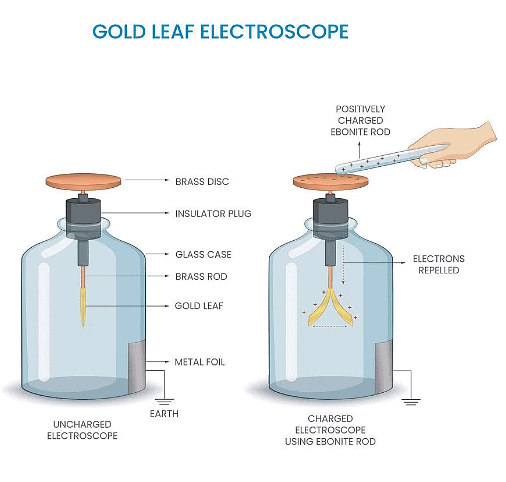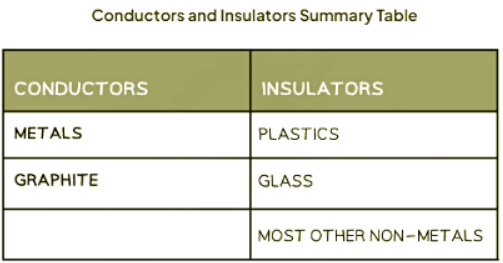Class 10 Exam > Class 10 Notes > Physics for GCSE/IGCSE > Investigating Conductors & Insulators
Investigating Conductors & Insulators | Physics for GCSE/IGCSE - Class 10 PDF Download
Conductors, Insulators & Electrons
- The distinction between conductors and insulators lies in their ability to conduct electricity:
- Conductors allow charge carriers to move freely, enabling the flow of electricity.
- Insulators prevent the movement of charge carriers, impeding the flow of electricity.
- The underlying cause for this contrast can be attributed to their internal composition.
Conductors
- A conductor is a substance that permits the easy flow of charge, typically electrons, through it.
- Examples of conductors include:
- Silver
- Copper
- Aluminium
- Steel
- Conductors tend to be metals

- At the atomic level, conductors consist of positively charged metal ions alongside their outermost electrons, which are delocalized.
- Consequently, electrons have the freedom to move within the conductor.
- Metals exhibit excellent electrical conductivity due to the following:
- Electrical current denotes the speed at which charged particles move.
- Therefore, the smoother the movement of electrons, the superior the conductivity of the conductor.

Insulators
- Insulators, on the other hand, are materials that do not have free charges readily available and therefore inhibit the flow of electrical charge.
- Common examples of insulators are rubber, plastic, glass, and wood.
- Even though insulators do not conduct electricity well, some non-metals like wood can allow a small amount of charge to pass, particularly in the form of static electricity.
- For instance, when two insulators come into contact, any accumulated charge on their surfaces can be conducted away.
Investigating Electrical Conductors & Insulators
- When exploring electrical conductors and insulators, a Gold-leaf electroscope (GLE) serves as a valuable tool. This device aids in distinguishing between the two types of materials.

- The Gold-leaf Electroscope consists of:
- A metal plate attached to one end of a metal rod.
- A very thin leaf of gold foil attached to the other end of the rod.
- The rod is held by an insulating collar inside a box with glass sides, ensuring visibility and protection of the gold leaf from disturbances.
- When the Gold Leaf Electroscope (GLE) becomes charged, the plate, rod, and gold leaf acquire identical charges, whether positive or negative.
- As both the rod and leaf possess the same charge, they undergo repulsion, causing the leaf to extend sideways.
- Upon discharge, when the rod and leaf reach a neutral state, the leaf returns to its hanging position.
Question for Investigating Conductors & InsulatorsTry yourself: What is the main difference between conductors and insulators?View Solution
Testing Electrical Conductors and Insulators
- Charge the plate of the Gold Leaf Electroscope (GLE) to make the gold leaf stand clear of the rod.
- Touch the plate of the GLE with items being tested:
- Metals: wire, paperclip, scissor blades
- Non-metals: paper, fingers, glass, graphite
- Plastics: plastic ruler, handles of scissors, finger in a plastic bag
- Comparisons: wet cloth, dry cloth; finger and finger in a plastic bag
- When observing the behavior of a leaf:
- A leaf falls promptly on a good conductor.
- If a leaf remains in place, it indicates the object is a poor conductor (good insulator).
- When a leaf falls slowly, it suggests the material is a poor conductor.
- Alternative Method:
- An electronic charge detector can be a substitute for the Gold-leaf Electroscope.
- Expected Results
- Metals are excellent conductors, while non-metals are commonly good insulators.

- Metals are excellent conductors, while non-metals are commonly good insulators.
The document Investigating Conductors & Insulators | Physics for GCSE/IGCSE - Class 10 is a part of the Class 10 Course Physics for GCSE/IGCSE.
All you need of Class 10 at this link: Class 10
|
126 videos|182 docs|35 tests
|
FAQs on Investigating Conductors & Insulators - Physics for GCSE/IGCSE - Class 10
| 1. What are some common examples of electrical conductors? |  |
Ans. Some common examples of electrical conductors include metals such as copper, aluminum, and gold. These materials allow the flow of electricity due to the movement of free electrons within their atomic structure.
| 2. How does the conductivity of a material affect its ability to conduct electricity? |  |
Ans. The conductivity of a material is a measure of how easily it allows the flow of electric current. Materials with high conductivity, such as metals, are good conductors of electricity as they have many free electrons that can move easily. In contrast, insulators have low conductivity as they do not have free electrons to carry the electric current.
| 3. How can you test if a material is a conductor or an insulator? |  |
Ans. You can test if a material is a conductor or an insulator by setting up a simple circuit with a battery, wires, and a light bulb. If the material allows the bulb to light up when connected to the circuit, it is a conductor. If the bulb does not light up, the material is an insulator.
| 4. Why are metals commonly used as electrical conductors? |  |
Ans. Metals are commonly used as electrical conductors due to their high conductivity. They have a large number of free electrons that can move easily through the material, allowing electricity to flow. This makes metals ideal for carrying electrical currents in various applications.
| 5. How does the concept of conductors and insulators relate to the flow of electrons in a circuit? |  |
Ans. In a circuit, conductors allow the flow of electrons, which carry the electric current from the power source to the load (such as a light bulb). Insulators, on the other hand, prevent the flow of electrons, helping to protect the circuit from short circuits and ensuring proper functioning of the electrical system.
Related Searches




















